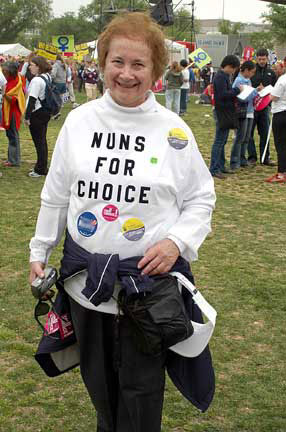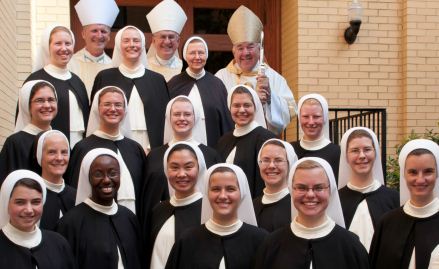 As the media fallout continues from the Vatican's decision to rein in the Leadership Conference of Women Religious (see the full document here), I have been especially interested in the degree to which journalists are certain that this action was rooted in tensions caused by recent debates over health care, abortion and homosexuality.
The key word that interests me is "recent."
As the media fallout continues from the Vatican's decision to rein in the Leadership Conference of Women Religious (see the full document here), I have been especially interested in the degree to which journalists are certain that this action was rooted in tensions caused by recent debates over health care, abortion and homosexuality.
The key word that interests me is "recent."
I say this because, long ago, during my days in Denver, I covered quite a few events related to the work of liberal nuns, events that had to be creating files of complaints in somebody's Vatican file cabinets. Nuns and feminism? Sure. Nuns and watered down forms of Wicca and neopaganism? Sure. Nuns and abortion rights? Sure.
In one memorable event, the famous duo of Sister Jeannine Gramick and Father Robert Nugent came to town for a New Ways Ministry mini-conference on fighting homophobia in the church. I registered as a reporter and took my tape recorder to the main sessions.
Big idea No. 1: Homophobia is a sin because it believes x, y and z. Big idea No. 2: Pope John Paul II needed to repent – the word "repent" was used – because he was clearly teaching doctrines x, y and z.
Thus, I wrote a story for the Rocky Mountain News stating that the conference leaders had said the pope was a homophobic sinner who needed to repent of teaching x, y and z. I backed this with lots of direct quotes.
The sister and the priest flipped out and told my editor they wanted a correction. They had not, you see, called the pope a "sinner."
I played my tape for my editor who, in more colorful language, said something like this: That's nuts. Of course they called the pope a sinner. Why did they say all that in public if they didn't want to be quoted saying it?
To some degree, this anecdote captures what I think this whole breaking story is about (click here for MZ's major post on the topic). For several decades now, all kinds of progressive nuns have been standing at podiums saying all kinds of interesting and/or unorthodox things and complaints have been stacking up in file cabinets at the Vatican. The key is that these events received very little attention in the mainstream press.
You see, this hot news story is roughly 25 years old. Nevertheless, many journalists are acting like this is a bizarre Vatican canon shot out of the blue and, thus, this has to be about President Barack Obama and health care.
When I started reading a new Los Angeles Times report on this subject, for several paragraphs I actually thought it was going to beat the odds and cover the obvious. Here's the start:
A group that represents the majority of Roman Catholic nuns in the United States has been chastised by the Vatican for deviating from church doctrine and promoting what the Holy See called "radical feminist themes."
The Leadership Conference of Women Religious said Thursday it would consult with its members to decide on a course of action after the church's three-year investigation resulted in the harsh assessment of its activities and a call for reform.
The Congregation for the Doctrine of the Faith — the enforcer of orthodoxy — criticized the group for "protesting the Holy See's actions regarding the question of women's ordination and of a correct pastoral approach to ministry to homosexual persons."
All the Times had to do was flesh out the phrase "radical feminist themes" with some hard comments, perhaps even quoting critics of the nuns to offer the other side, and the larger picture would have come into focus.
But no, instead we get this:
The conference, based in Silver Spring, Md., is an umbrella organization for other groups composed of Catholic nuns. The conference says it has more than 1,500 members representing more than 80% of the 57,000 women religious in the United States. The group represents the majority of nuns who work in education, healthcare, religious education and social services.
Network gained notoriety in recent years when it supported the Obama administration's sweeping healthcare bill. The U.S. Conference of Catholic Bishops vehemently opposed it.
So what are the doctrinal issues that are at the heart of this dispute, other than issues linked to sexual ethics? The Times does not have a clue, in large part because no one interviewed (a) any critics of the liberal nuns or, specifically, (b) any conservative sisters from the Council of Major Superiors of Women Religious – a group formed for those who have opposed the doctrinal innovations of the Leadership Conference of Women Religious.
That's a rather important hole in the story.
 Here's another one, as captured in the “Recent Vocations to Religious Life” study from Georgetown University’s Center for Applied Research. Religion writer Julia Duin wrote about some of its key stats in a piece for The Washington Times.
Here's another one, as captured in the “Recent Vocations to Religious Life” study from Georgetown University’s Center for Applied Research. Religion writer Julia Duin wrote about some of its key stats in a piece for The Washington Times.
Several years ago, Duin wrote:
Compared to the 1960s, when there were 23,000 priests, 12,500 brothers (monks) and about 180,000 sisters (nuns), the religious population has decreased by 65 percent. ... Today there are about 13,000 priests in religious orders, 5,000 brothers and 59,000 sisters. Seventy-five percent of men and more than 90 percent of the women are at least 60 years old. Of those who are younger than 60, the majority are in their 50s, with only 1 percent younger than 40.
(That 1 percent, I am guessing, belongs to the Dominican Sisters of St. Cecilia in Nashville, now numbering more than 250 women, who limit their candidate pool to women 30 and younger. They’ve got 23 postulants this year alone; the largest number of new nuns in training in the country. Which may be why I’m getting fundraising letters from them asking for money to feed, house and train these women.)
So there is a demographics battle going on behind the scenes, with the progressive orders graying and fading, while smaller and younger orders are offering a more traditional approach to religious life.
Consider this passage in the famous speech on moving "beyond Jesus," delivered by Sinsinawa Dominican Sister Laurie Brink at the 2007 national gathering of the Leadership Conference of Women Religious. This is from a Scripps Howard column I drew from her transcribed text.
Sister Laurie said that struggling and aging orders faced several tough options as they looked to the future.
The first option, she said, is “death with dignity and grace,” as opposed to becoming a “zombie congregation” that staggers on with no purpose. This option must be taken seriously since the average age of the 67,000 sisters and nuns in the United States is 69. Many retreat ministries are closing and large “mother houses” are struggling with finances, while some congregations no longer invite or accept new candidates.
Meanwhile, Brink noted with sadness, some orders have chosen to turn back the clock – thus winning the favor of Rome. “They are putting on the habit, or continuing to wear the habit with zest. ... Some would critique that they are the nostalgic portrait of a time now passed. But they are flourishing. Young adults are finding in these communities a living image of their romantic view of Religious Life. They are entering. And they are staying,” she said.
In other words, has the Vatican cast its lot with these small, yet growing orders, the ones with the young women who want to practice a more traditionalist approach to religious life? Might that be a part of this story worth covering?
This would, of course, require journalists to break down and talk to some of these young romantic sisters and their leaders.
SECOND IMAGE: Young nuns in Nashville, incoming.
